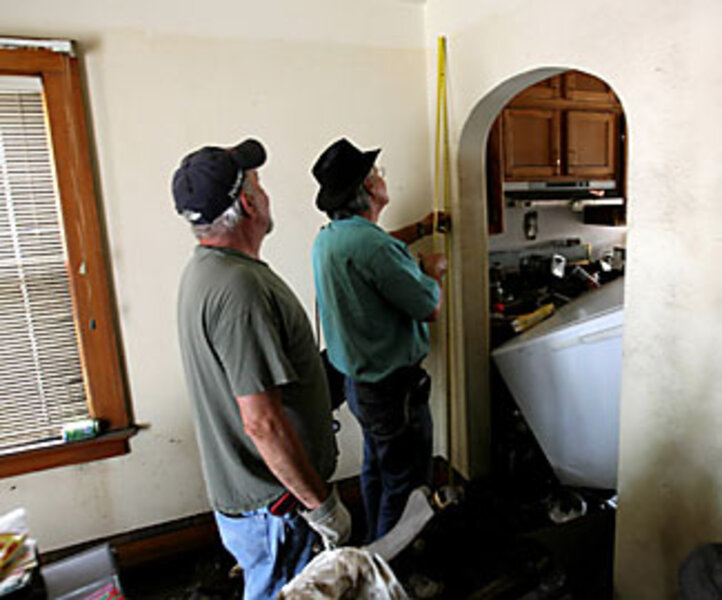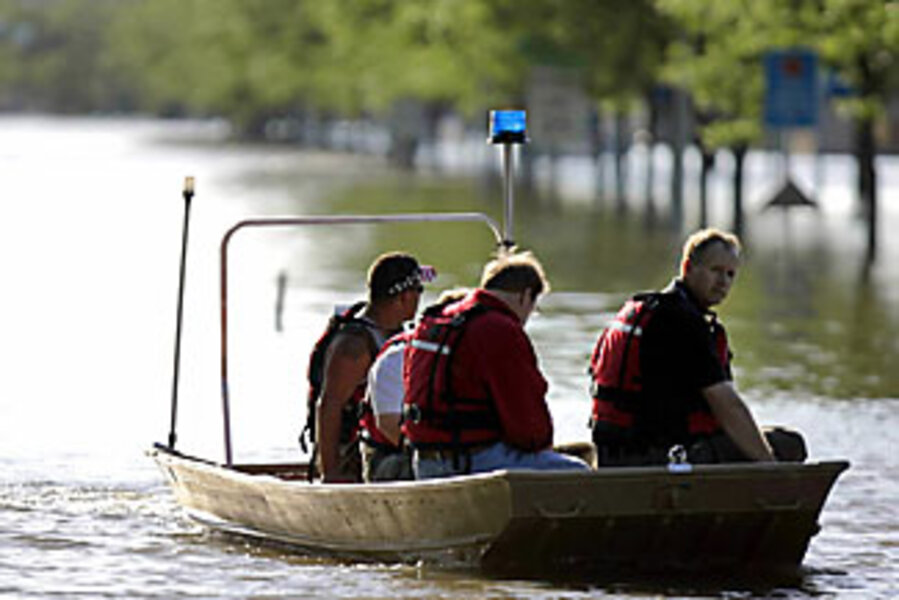After this flood, FEMA earns praise
| Wapello, Iowa
When the prospect of major flooding in Iowa loomed more than three weeks ago, the state's emergency management office got busy.
Local officials were alerted, sandbags were sent out, and the office's new software kept track of emergency missions and allowed local groups to check on how quickly their requests for sandbags or water were being fulfilled.
The impact of the floods – in terms of homes and businesses destroyed, crops ruined, and property lost – has been severe. But the perception of how well the federal, state, and local emergency responders performed, from Federal Emergency Management Agency (FEMA) on down, contrasts sharply with the criticism such entities received after hurricane Katrina, the 1993 floods, and other recent disasters.
"It's been mostly positive," says Dan Wilson, mayor of Columbus Junction, Iowa, which experienced substantial flooding when a levee overflowed. "Everything we did in preparation ... from preparedness to recovery, I thought we had a lot of help along the way."
Such positive reviews are a welcome change for government agencies, and particularly for FEMA, which had been widely derided after its Katrina response.
"FEMA learned a lot of lessons from its performance during Katrina and Rita," says Harvey Johnson, deputy administrator for FEMA. In particular, he cites the agency's quick deployment of supplies – water, packaged meals, generators, cots – to states even before the flooding occurred or disaster declarations were issued.
"We're trying to look ahead and anticipate, rather than wait until the event occurs and clang the bell, and respond late," says Mr. Johnson.
There's been a much greater effort to coordinate with state and local governments, he adds, and ensure that FEMA's response is appropriate. When Cedar Rapids recently requested several hundred mobile homes, FEMA first checked in with the state government. It also listened to the city's request to lease areas in existing mobile-home parks, rather than setting up the sort of group sites that were so criticized after Katrina.
The agency also pushed to get the necessary disaster declarations out faster and to conduct housing inspections and issue federal payments more quickly.
Long-term recovery – involving more regulations and red tape – can be slower and more frustrating, Johnson acknowledges. But there's a huge effort being made to do things differently, he says. "We have a sense of needing to improve ourselves, and to show people that the new FEMA is more than just a bumper sticker," he says.
High marks for local agencies
While FEMA is getting much of the scrutiny, many of the most important initial responders were state and local groups. And for the most part, they've also received high marks for quick, clear communication with residents, and for efforts that in some cases allowed key public works to be saved or gave people time to remove their possessions.
"I don't think they could have done a better job," says Joleen Gerst, whose farm in Oakville, Iowa, flooded when the levee there was overtopped. In the days leading up to the flood, she received daily "code red" calls updating her on the situation, she says. Volunteers from all over the country helped her and other Oakville residents evacuate, and over 1,000 sandbaggers were used to shore up the levee.
Since the flood, she says she and her husband have already received assistance from FEMA and were told they could apply for temporary housing and even have it located at their farm if they liked.
"The emergency management teams were excellent," she says. "They did everything in their power to keep people safe."
A big part of the improvement from the 1993 Midwest floods, in which many more people were caught off guard, has to do with improved technology and enhanced emergency management centers, say officials.
"People were still putting stuff up on a chalkboard in '93," says Bret Voorhees, a spokesperson for Iowa Homeland Security and Emergency Management. After the Sept. 11 attacks, Iowa, like other states, took advantage of federal funds to beef up its emergency response center. These days, it occupies a large building with 70 computer-equipped workstations.
"Having a place that's big enough, and having trained repeatedly since '93 – all that aided our response dramatically," says Mr. Voorhees.
The Army Corps of Engineers helped get much of the information out about threatened levees, regularly updating their website. As soon as it looked as if flooding was a possibility, the Corps notified commercial tows so they could get out of the Mississippi River system and not be stranded when the locks were shut down, says Ron Fournier, a spokesperson for the Corps's Rock Island District.
They also worked with Des Moines and Iowa City, both located near reservoirs, holding back on their scheduled water releases as long as possible to allow the cities to protect schools, water treatment plants, and other key facilities.
And in many ways, the fairly smooth response was aided by a public who had been through similar floods just 15 years earlier. "They understood how to evacuate better," says Mr. Fournier. "After '93, people realized what could happen."
Jury still out on recovery
Some of the quick response was able to save towns. In Cedar Falls, Iowa, sandbags were dispatched and volunteers worked around the clock to raise levees; the town was largely spared.
In the case of Cedar Rapids, the Iowa River rose dramatically higher than expected, augmented by five inches of rain on the day of the flood, and little could be done. Some 25,000 people were evacuated – in many cases they were notified by a reverse 911 system the city had in place – and emergency shelters were set up.
In some ways, comparisons to Katrina are inapt, say experts. The magnitude of that event was so much greater, occurring in a far larger city than any of the towns affected in the recent floods and an area of the country that may have had less government capability than the Midwest.
But it's still one of the first major post-Katrina disasters in which FEMA has been able to redeem itself – though some point out that the much longer recovery phase, which FEMA has a larger role in than the immediate evacuation, is only beginning.
Frustrations are likely to grow as people get impatient for housing and for answers about compensation or buyouts. And local officials say navigating the many different agencies can be confusing.
"You saw a response that was much better [than in '93], and an immediate recovery phase that was improved," says Larry Larson, executive director of the Association of State Floodplain Managers. "Now we're into long-term recovery and mitigation, and that jury is still out."






